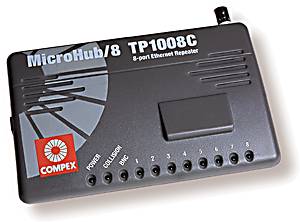
Ethernet hub
Q0005
The Ethernet hub is an item of network equipment that allows multiple devices to communicate on the same Ethernet. Hubs are fairly simple devices, consisting of several ports to which network devices can be connected, and sometimes an additional port to which another hub can be connected.
The Ethernet hub is used as a central connection point for a small network. All workstations, printers and routers or modems on the network will be connected at the hub. This is referred to as a star wired network topology. The hub has a number of ports for connecting devices. Each device to be connected to the hub must be Ethernet ready, with either a built in Ethernet port or an Ethernet card. Printers have special cards called print servers. These can be either internal or external to the printer.
A 10BaseT or 100BaseT Ethernet hub (10 or 100 mbps over twisted pair cabling) does two things:
An Ethernet hubs data capacity for ALL ports combined is limited to the bandwidth of the Ethernet type used. This means that on a 10BaseT network, if 8 devices are connected to a hub, all communication from these devices must share the 10mbps of bandwidth in the hub. This example shows one of the main limitations of a hub. If all 8 devices were transmitting the full 10mbps of data possible, the hub would be overwhelmed with 80mbps of traffic.
